#Rin Kazari
Explore tagged Tumblr posts
Text
Most formal outfits for upper ranks samurai - Sokutai and Ikan formal court dress
(as worn by upper-ranked samurai of the Edo period - great charts by Nadeshico Rin). You can find more about samurai ranks and their regulated attires under the tag "samurai kimono".
The Sokutai
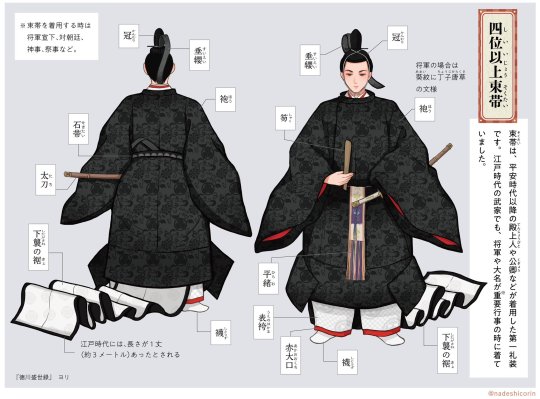
束帯 Sokutai is the most formal attire worn by Edo period samurai of the 4th rank and above.
It first appeared during Heian era as a ceremonial court dress worn by 公卿 kuge (nobility/Imperial court) and 殿上人tenjôbito (courtiers/court officials). Usage was kept well into Edo period by both the Imperial court and the Tokugawa shogunate.
The intricated garb includes:
冠 Kanmuri - hat, with distinctive 垂纓 suiei "tail" hanging in the back. Materials could include silk, lacquer or horsehair and were strickly regulated
袍 Hô - a round-necked robe with large boxy sleeves. Colors and patterns were strickly regulated.
Shown here is a pattern used by the Shôgun, the 葵に丁子唐草 Aoi ni chôji karakusa (cloves with arabesques, and hollyhock leaves - which is the Tokugawa crest)
笏 Shaku - flat ritual sceptre
平緒 Hirao - a wide flat braid wrapped around the body with ties left hanging up front. Colors and weaves were strickly regulated
(飾)太刀 (Kazari)-Tachi - (mock) long sword for ceremonial use
表�� Ue-no-bakama (or omote-bakama) - white overpants, shorter hakama pants worn over the aka-ôkuchi
赤大口(袴) Aka-ôkuchi(bakama) - red underpants, a tad longer than the overpants
下襲(の裾) Shitagasane(no-kyo) - visible train part of an inner robe worn under the 袍 hô. During Edo period, train lenght got up to 1丈 (around 3 meters/10 feet).
襪 Shitôzu - a type of ancient socks (construction is different than tabi - they don't have a sole for ex.)
石帯 Sekitai - leather belt used in ceremonial court dress, covered in black lacquer, and decorated with stones and jewels
The Ikan
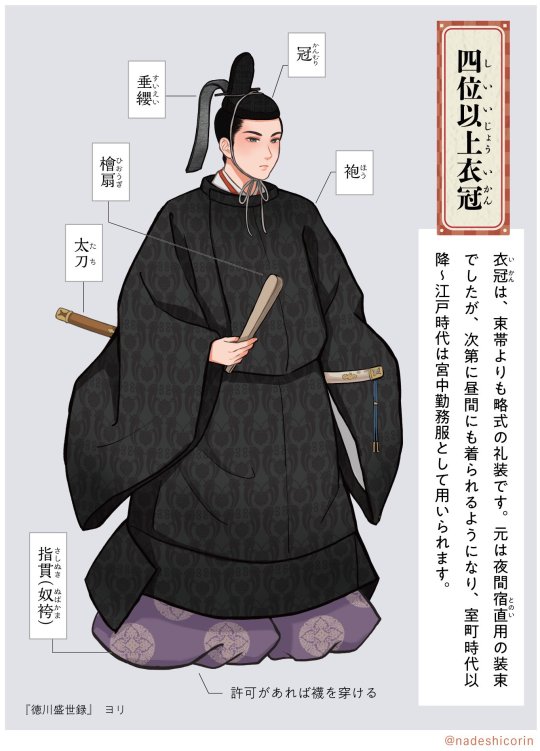
衣冠 Ikan - while still very formal and worn by Edo period samurai of the 4th rank and above, ikan looked much more simpler than sokutai.
First used for nightime duties (夜間宿直) in Heian era, it gradually came to be worm during daytime too. From Muromachi period and onwards, it had become the work uniform of the Imperial court.
Like sokutai, it uses the hô+kanmuri, and wearers were allowed to carry kazari-tachi. Yet, note how the pants differ from sokutai ones: those are large bouffant pants called 指貫 sashinuki (or 奴袴 nubakama).
You can also note that wearer here is not holding a shaku scepter: it's a folded 檜扇 hiôgi (formal folding fan made of cypress also of Heian history. Those were unpatterned as painted ones were for women).
#japan#fashion#fashion history#nadeshico rin#samurai kimono#samurai#buke#warrior class#sokutai#ikan#edo period#edo era#heian period#reference#ressources#men kimono#着物#Kanmuri#Hou#Shaku#Hirao#Tachi#Ue-no-bakama#omote-bakama#Aka-ôkuchi#Shitagasane#Shitôzu#Sekitai#Ikan#sashinuki
335 notes
·
View notes
Text

21 notes
·
View notes
Photo

Sansha NPC frigate (Niarja) - Rin Kazari - Witchcraft Works
A little experiment with Sansha’s hull light reflections. Look nice to use it on the others later.
4 notes
·
View notes
Note
So, they have…
Tanpopo Kuraishi: 16
Mei Menowa: 17
Rin Kazari: 14
Kanna Utsugi: 15
Kotetsu Katsura: 16 (the same age as Tanpopo)
I wonder, how old were Tanpopo Kuraishi and her friends? Tanpopo Kuraishi and her friends are from the Tower Witches from Witch Craft Works

I really don't know this anime very well at all, but I guess those school mates are in a normal teenager age, between 14 and 17
#Witchcraft Works#Witch Craft Works#KMM Gang#Tanpopo Kuraishi#Mei Menowa#Rin Kazari#Kanna Utsugi#Kotetsu Katsura#thedarkwizardisaevillizard#answered questions#age ask
1 note
·
View note
Photo










#ones missing but shhhhh#Witchcraft Works#WCW#tanpopo#kazari rin#katsura kotetsu#menowa mei#utsugi kanna#anicaps
32 notes
·
View notes
Text
ISML 2021: Nominations List
ISML 2021: Nominations List
Female Division
Rank Name Series Ballots
- Misaka Mikoto Toaru Series Auto
- Emilia Re:Zero kara Hajimeru Isekai Seikatsu Auto
- Iwanaga Kotoko Kyokō Suiri Auto
- Ichinose Chizuru (Mizuhara Chizuru) Kanojo, Okarishimasu Auto
- Shirogane Kei Kaguya-sama wa Kokurasetai Auto
- Elaina Majo no Tabitabi Auto
- Sakurajima Mai AoButa Auto
- Yuigahama Yui OreGairu Auto
- Tōsaka Rin Fate Series Auto
- Shiro No Game No Life Auto
- Isshiki Iroha OreGairu Auto
- Shokuhō Misaki Toaru Series Auto
- Fujiwara Chika Kaguya-sama wa Kokurasetai Auto
- Tokisaki Kurumi Date A Live Auto
- Hayasaka Ai Kaguya-sama wa Kokurasetai Auto
- Yūki Asuna Sword Art Online Auto
- Takanashi Rikka Chūnibyō demo Koi ga Shitai! Auto
- Shiina Mashiro Sakura-sō no Pet na Kanojo Auto
- Shinomiya Kaguya Kaguya-sama wa Kokurasetai Auto
1 Zero Two Darling in the FranXX 383
2 Tomori Nao Charlotte 148
3 Izumi Sagiri Eromanga Sensei 135
4 Isla Plastic Memories 123
5 Tachibana Kanade Angel Beats! 121
6 Nishimiya Shōko Koe no Katachi 120
7 Ichigo Darling in the FranXX 120
8 Miyamizu Mitsuha Kimi no Na wa 115
9 Saber Fate Series 111
10 Yuzaki Tsukasa Tonikaku Kawaii 109
11 Kochō Shinobu Kimetsu no Yaiba 102
12 Kasumigaoka Utaha Saenai Heroine no Sodatekata 98
13 Kasugano Sora Yosuga no Sora 95
14 Miyazono Kaori Shigatsu wa Kimi no Uso 91
15 Kanna Kamui Kobayashi-san Chi no Maid Dragon 90
16 Index L. Prohibitorum Toaru Series 89
17 Makise Kurisu Steins;Gate 85
18 Akiyama Mio K-ON! 84
19 Shirai Kuroko Toaru Series 83
20 Hirasawa Yui K-ON! 79
21 Kitashirakawa Tamako Tamako Market 78
22 Amano Hina Tenki no Ko 72
23 Sawamura Spencer Eriri Saenai Heroine no Sodatekata 71
24 Kuriyama Mirai Kyōkai no Kanata 69
25 Schwi Dola No Game No Life 68
26 Furukawa Nagisa CLANNAD 68
27 Akame Akame ga Kill! 67
28 Aisaka Taiga Toradora! 66
29 Yoshino Date A Live 66
30 Aoyama Nanami Sakura-sō no Pet na Kanojo 66
31 Kaname Madoka Puella Magi Madoka ☆ Magica 65
32 Akemi Homura Puella Magi Madoka ☆ Magica 64
33 Horikita Suzune Yōkoso Jitsuryoku Shijō Shugi no Kyōshitsu e 63
34 Ōmae Kumiko Hibike! Euphonium 61
35 Tōru Kobayashi-san Chi no Maid Dragon 61
36 Kafū Chino Gochūmon wa Usagi Desu ka? 60
37 Sora Ginko Ryuō no Oshigoto! 59
38 Yatogami Tōka Date A Live 59
39 Nakano Azusa K-ON! 59
40 Ichigyō Ruri Hello World 58
41 Saten Ruiko Toaru Series 57
42 Doma Umaru Himōto! Umaru-chan 57
43 Megumin KonoSuba 54
44 Yuzuriha Inori Guilty Crown 54
45 Azusagawa Kaede AoButa 48
46 Makinohara Shōko AoButa 45
47 Yamauchi Sakura Kimi no Suizo wo Tabetai 44
48 Chtholly Nota Seniorious SukaSuka 44
49 Kirisaki Chitoge Nisekoi 44
50 Hyūga Hinata NARUTO 44
51 Kōsaka Reina Hibike! Euphonium 44
52 Honma Meiko AnoHana 43
53 Illyasviel von Einzbern Fate Series 43
54 Hiiragi Shinoa Owari no Seraph 41
55 Kinomoto Sakura Cardcaptor Sakura 41
56 Takagi Karakai Jōzu no Takagi-san 39
57 Matō Sakura Fate Series 38
58 Sakurasawa Sumi Kanojo, Okarishimasu 37
59 Sento Isuzu Amagi Brilliant Park 37
60 Sakura Chiyo Gekkan Shōjo Nozaki-kun 36
61 Suzumiya Haruhi Suzumiya Haruhi no Yūutsu 36
62 Tobiichi Origami Date A Live 36
63 Nibutani Shinka Chūnibyō demo Koi ga Shitai! 34
64 Rachel Gardner Satsuriku no Tenshi 33
65 Saya Majo no Tabitabi 33
66 Hoto Kokoa Gochūmon wa Usagi Desu ka? 33
67 Sarashina Ruka Kanojo, Okarishimasu 32
68 Futaba Rio AoButa 32
69 Nakamura Yuri Angel Beats! 31
70 Karuizawa Kei Yōkoso Jitsuryoku Shijō Shugi no Kyōshitsu e 30
71 Kotobuki Tsumugi K-ON! 30
72 Kyaru Princess Connect! Re:Dive 29
73 Aqua KonoSuba 28
74 Nakano Yotsuba 5-tōbun no Hanayome 27
75 Misaki Mei Another 27
76 Dekomori Sanae Chūnibyō demo Koi ga Shitai! 27
77 Sōryū Asuka Langley Neon Genesis Evangelion 26
78 Krul Tepes Owari no Seraph 26
79 Nagato Yuki Suzumiya Haruhi no Yūutsu 25
80 Honjō Kaede(Maple) BOFURI 24
81 Oshino Shinobu Monogatari Series 24
82 Alice Zuberg Sword Art Online 24
83 Beatrice Umineko no Naku Koro ni 24
84 Gasai Yuno Mirai Nikki 23
85 Uiharu Kazari Toaru Series 23
86 Jabami Yumeko Kakegurui 22
87 Gray Fate Series 22
88 Yue Arifureta Shokugyō de Sekai Saikyō 21
89 Shiba Miyuki Mahōka Kōkō no Rettōsei 21
90 Rias Gremory Highschool D×D 21
91 Ayanami Rei Neon Genesis Evangelion 21
92 Asada Shino Sword Art Online 21
93 Shichimiya Satone Chūnibyō demo Koi ga Shitai! 21
94 Furuhashi Fumino Bokutachi wa Benkyō ga Dekinai 20
95 Tenma Gabriel White Gabriel Dropout 20
96 Iki Hiyori Noragami 20
97 Natsukawa Masuzu OreShura 20
98 Victorique de Blois GOSICK 20
99 C.C. Code Geass 19
100 Aragaki Ayase Ore no Imōto 19
101 Kokkoro Princess Connect! Re:Dive 19
102 Yūki Setsuna Love Live! NijiGaku 19
103 Holo Spice and Wolf 19
104 Sonozaki Noriko Kiznaiver 19
105 Raphtalia Tate no Yūsha no Nariagari 19
106 Kōsaka Kirino Ore no Imōto 19
Male Division
Rank Name Series Ballots
- Tachibana Taki Kimi no Na wa Auto
- Kanda Sorata Sakura-sō no Pet na Kanojo Auto
- Okazaki Tomoya CLANNAD Auto
- Satō Kazuma KonoSuba Auto
- Okabe Rintarō Steins;Gate Auto
- Saitama One-Punch Man Auto
- Totsuka Saika OreGairu Auto
- Archer Fate Series Auto
- Natsuki Subaru Re:Zero kara Hajimeru Isekai Seikatsu Auto
- Ayanokōji Kiyotaka Yōkoso Jitsuryoku Shijō Shugi no Kyōshitsu e Auto
- Riku Dola No Game No Life Auto
- Togashi Yūta Chūnibyō demo Koi ga Shitai! Auto
- Ishigami Yū Kaguya-sama wa Kokurasetai Auto
- Kamijō Tōma Toaru Series Auto
- Azusagawa Sakuta AoButa Auto
- Gilgamesh Fate Series Auto
1 Hiro Darling in the FranXX 248
2 Kirigaya Kazuto Sword Art Online 86
3 Otosaka Yū Charlotte 76
4 Levi Shingeki no Kyojin 70
5 Yuzaki Nasa Tonikaku Kawaii 67
6 Kaneki Ken Tokyo Ghoul 67
7 Uchiha Itachi NARUTO 59
8 Otonashi Yuzuru Angel Beats! 51
9 Itadori Yūji Jujutsu Kaisen 50
10 Emiya Shirō Fate Series 50
11 Eren Yeager Shingeki no Kyojin 48
12 Ishigami Senkū Dr.STONE 44
13 Yato Noragami 43
14 Arima Kōsei Shigatsu wa Kimi no Uso 38
15 Takasu Ryūji Toradora! 38
16 Lelouch Lamperouge Code Geass 38
17 Hyakuya Mikaela Owari no Seraph 36
18 Itsuka Shidō Date A Live 36
19 Saiki Kusuo Saiki Kusuo no Ψ Nan 33
20 Ōma Shū Guilty Crown 33
21 Hyakuya Yūichirō Owari no Seraph 33
22 Morishima Hodaka Tenki no Ko 32
23 Ishida Shōya Koe no Katachi 32
24 Kūjō Jōtarō JoJo's Bizarre Adventure 32
25 Goro Darling in the FranXX 30
26 Isaac Foster Satsuriku no Tenshi 30
27 Kasugano Haruka Yosuga no Sora 30
28 Kuroba Kaito Detective Conan 30
29 Dazai Osamu Bungō Stray Dogs 28
30 Araragi Koyomi Monogatari Series 27
31 Katagaki Naomi Hello World 26
32 Sakata Gintoki Gintama 26
33 Uesugi Fūtarō 5-tōbun no Hanayome 25
34 Rengoku Kyōjurō Kimetsu no Yaiba 24
35 Ōji Mochizō Tamako Market 24
36 Fushiguro Megumi Jujutsu Kaisen 24
37 Shiota Nagisa Ansatsu Kyōshitsu 23
38 Uchiha Sasuke NARUTO 22
39 Tomioka Giyū Kimetsu no Yaiba 21
40 Fukube Satoshi Hyōka 21
41 Izumi Masamune Eromanga Sensei 20
42 Mizugaki Tsukasa Plastic Memories 20
43 Kanbara Akihito Kyōkai no Kanata 20
44 Waver Velvet Fate Series 20
45 Dio Brando JoJo's Bizarre Adventure 19
46 Ainz Ooal Gown Overlord 19
47 Kyon Suzumiya Haruhi no Yūutsu 19
48 Iwatani Naofumi Tate no Yūsha no Nariagari 19
49 Kuzuryū Yaichi Ryuō no Oshigoto! 19
50 Yagami Light Death Note 18
51 Yugi Amane(Hanako-kun) Jibaku Shōnen Hanako-kun 18
52 Kurogane Ikki Rakudai Kishi no Cavalry 17
53 Kanie Seiya Amagi Brilliant Park 17
54 Son Goku Dragon Ball 17
55 Akasaka Ryūnosuke Sakura-sō no Pet na Kanojo 17
56 Ryūgūin Seiya Shinchō Yūsha: Kono Yūsha ga Ore TUEEE Kuse ni Shinchō Sugiru 16
57 Gilbert Bougainvillea Violet Evergarden 16
58 Sakamaki Izayoi Mondaiji 16
59 Uchiha Madara NARUTO 16
60 Narihisago Akihito Id:Invaded 15
61 Rudeus Greyrat Mushoku Tensei 15
62 Kinoshita Kazuya Kanojo, Okarishimasu 14
63 Aki Tomoya Saenai Heroine no Sodatekata 14
64 Shinei Nouzen 86 -Eighty Six- 14
65 Inumaki Toge Jujutsu Kaisen 14
66 Emiya Kiritsugu Fate Series 14
67 Joseph Joestar JoJo's Bizarre Adventure 13
68 L Lawliet Death Note 13
69 Kurosaki Ichigo BLEACH 13
70 Shiba Tatsuya Mahōka Kōkō no Rettōsei 13
71 Bell Cranel DanMachi 13
72 Kageyama Shigeo Mob Psycho 100 13
73 Willem Kmetsch SukaSuka 13
74 Ryo Fu Hōsen Shūmatsu no Valkyrie 13
75 Akabane Karma Ansatsu Kyōshitsu 12
76 Hashibira Inosuke Kimetsu no Yaiba 12
77 Mochizuki Tōya Isekai wa Smartphone to Tomo ni. 12
78 Kaizaki Arata ReLIFE 12
79 Tatsumi Akame ga Kill! 12
80 Sakakibara Kōichi Another 12
81 Uchiha Obito NARUTO 12
82 Keyaru Kaifuku Jutsushi no Yarinaoshi 12
83 Hyōdō Issei Highschool D×D 11
84 Reigen Arataka Mob Psycho 100 11
85 Eugeo Sword Art Online 11
86 Ciel Phantomhive Kuroshitsuji 11
87 Edward Elric Fullmetal Alchemist 11
88 Glenn Radars Rokudenashi Majutsu Kōshi to Akashic Record 11
89 Ōsaka Sōgō Idolish7 11
90 Nishikata Karakai Jōzu no Takagi-san 11
91 Anos Voldigoad Maō Gakuin no Futekigōsha 11
92 Asanaka Yomogi SSSS.DYNAZENON 11
93 Sano Manjirō Tokyo Revengers 10
94 Nagumo Hajime Arifureta Shokugyō de Sekai Saikyō 10
95 Tatsumi Kōtarō Zombieland Saga 10
96 Tomoe Kamisama Hajimemashita 10
97 Inuyasha InuYasha 10
98 Satoshi Pokémon 10
99 Nohara Shinnosuke Crayon Shin-chan 10
100 Sesshōmaru InuYasha 10
101 Erwin Smith Shingeki no Kyojin 10
102 Odokawa Hiroshi Odd Taxi 9
103 Yukihira Sōma Shokugeki no Sōma 9
104 Hinata Shōyō Haikyū!! 9
105 Yadomi Jinta AnoHana 9
106 Ikari Shinji Neon Genesis Evangelion 9
107 Nakahara Chūya Bungō Stray Dogs 9
108 Usui Takumi Kaichō wa Maid-sama! 9
7 notes
·
View notes
Text
Koizumi Kyoko Lyrics: Dakara Dakishimete (だから抱きしめて; So Hold Me)
English translation and romanization below the cut. Thank you @theysbian for the coffee!
ENGLISH
Ooh, shoobie doobie shoobie do-wo-o-p Ooh, shoobie doobie shoobie do-wop Ooh, shoobie doobie shoobie do-wo-o-p Ooh, shoobie do-wo-o-p
We found a pink clam shell As I walked down the beach in the moonlight with you My earrings, your love Swinging back and forth on my ears
I was drunk, intoxicated On that modest bit of happiness Even though I knew in my heart the dream would end someday
I’m nothing but sighs From night after hard night, so hold me in your arms, darling Ooh, shoobie doobie shoobie do-wo-o-p Ooh, shoobie doobie shoobie do-wop Ooh, shoobie doobie shoobie do-wo-o-p Ooh, shoobie do-wo-o-p
I watched the burning sun set with you Two shadows on the seashore at twilight When we snuggled up against each other, Your love would swing back and forth on my shoulders
The dream’s just too brief, darling, to be in love I’d just find out how lonely it is to be alone tomorrow
Your flightiness is making my mind so crazy That I can’t fall asleep So hold me in your arms, darling Until my tears dry Ooh, shoobie doobie shoobie do-wo-o-p Ooh, shoobie doobie shoobie do-wop Ooh, shoobie doobie shoobie do-wo-o-p Ooh, shoobie do-wo-o-p... F.O.
ROMAJI
u- shubi dubi shubi du wappappa u- shubi dubi shubi du wappa u- shubi dubi shubi du wappappa u- shubi du wappa
anata to aruku mu-nraito bi-chi futari de sagashita sakura-gai mimi-kazari anata no ai mimimoto de yurete ita
sonna sasayaka na shiawase ni yoishirete ita watashi itsuka wa owaru yume to kokoro de shirinagara
setsunai yoru wo kasanete wa tameiki bakari dakara dakishimete da-rin u- shubi dubi shubi du wappappa u- shubi dubi shubi du wappa u- shubi dubi shubi du wappappa u- shubi du wappa
anata to mite’ta moeru sansetto tasogare no nagisa futatsu no kage yorisoeba anata no ai katasaki de yurete ita
yume wa tsuka no ma da-rin ai suru hodo ni ashita wa tada hitori no sabishisa shiru bakari
kimagure shigusa ni kokoro ga midasarete nemurenai dakara dakishimete da-rin namida ga kareru made u- shubi dubi shubi du wappappa u- shubi dubi shubi du wappa u- shubi dubi shubi du wappappa u- shubi du wappa
4 notes
·
View notes
Photo
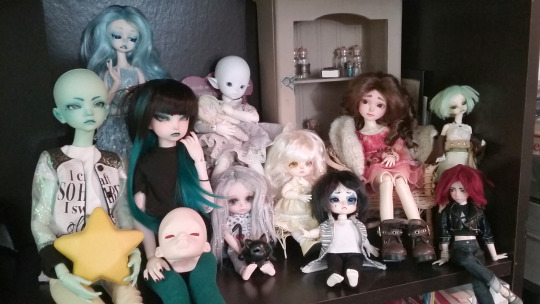
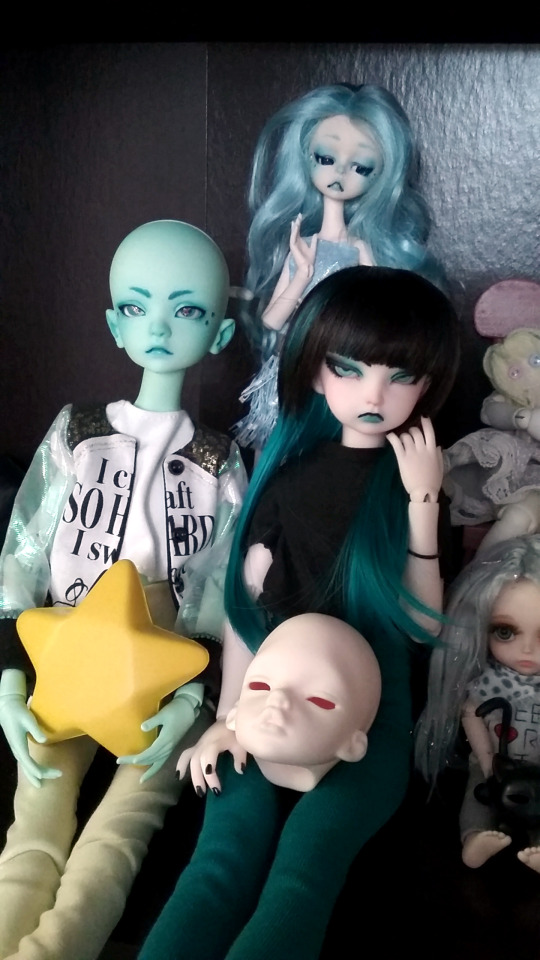
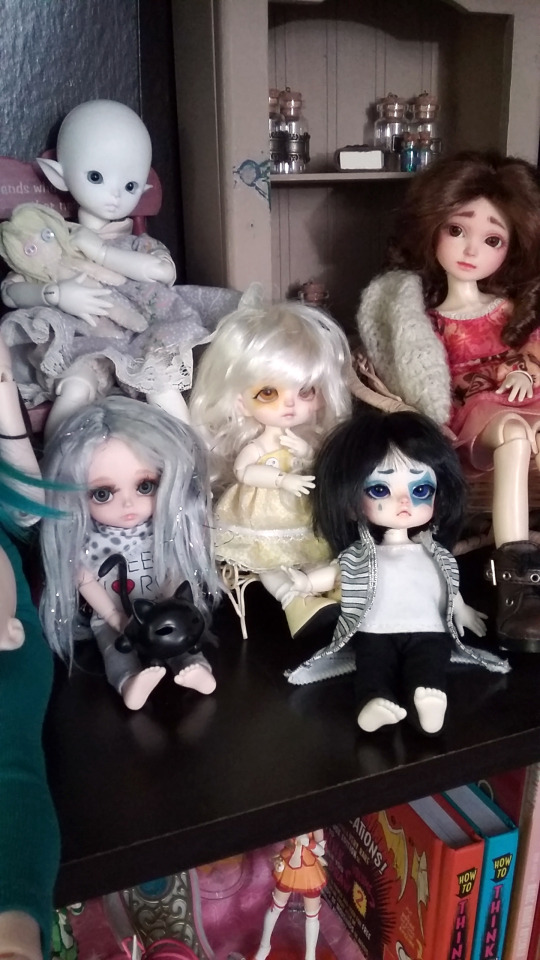
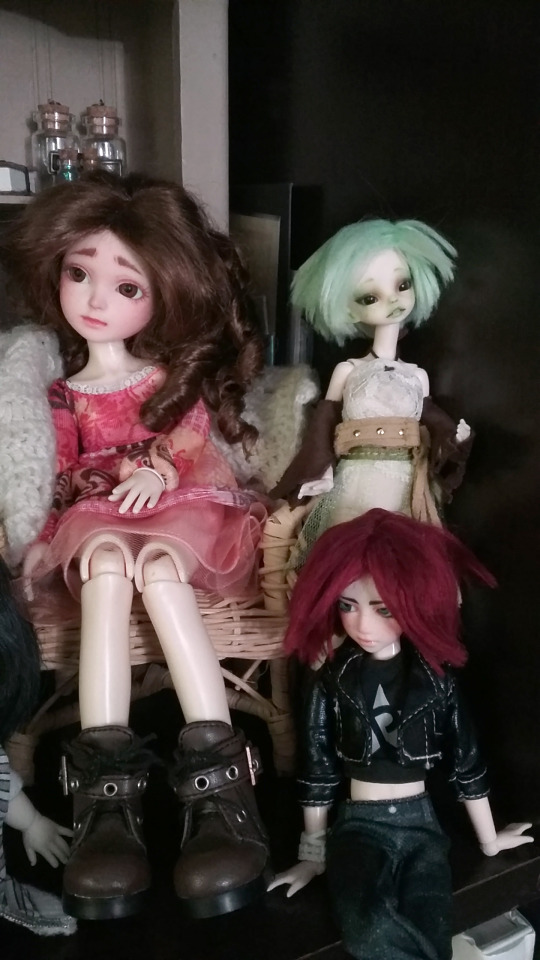
Happy new year!! I was too tired this week with all the goings-on, but here’s my 2019 end-of-year photo! I didn’t get to this for 2018, which I regret- but my little family doubled since then, so it feels like a great time to start! These photos aren’t the best, but I didn’t wanna set something fancy up when me and the boo are in the middle of re-arranging our bedroom- I’ll save that for when they’re ready for photoshoots this year. 💦
Anyway, from left to right, there’s Starchaser (DC Bella in green skin), Pisces (DC Wanda, in the back), Void-Hime (LS Wanwan), [redacted] (DIM Laia HCE head- and my only floating head, yay!), Cecelia (DF-A Bibi + LTF body, sitting in the chair), My nameless Lati Yellow Sunny holding a Kazari (Sakura & Paper) I got as a gift, Pollyanna (LTD Tyltyl), Cassidy (LTD Jack), Olive (BBB Isabella), March (Dollzone Ivy), and Hye-Rin (Nano Haruka 21cm Obitsu) sitting in front!
I included Sunny and Kazari for the time being since the two seem to like to hang out on my shelf instead of being boxed- but I haven’t decided if I’ll keep them yet, hence them not being named. I’m excited to see how this bunch evolves by the end of 2020! I have some 2019 reflections and 2020 doll/craft goals forthcoming, if I can sit still long enough to get to them!! 😂
#textposts#photoshoots#doll chateau bella#longsoul wanwan#luts tiny delf#luts tiny delf jack#luts tiny delf tyltyl#bobobie isabella#doll in mind laia#doll family a#obitsu#dollzone#doll chateau#loongsoul#void hime#starchaser#castor#pollux#march#pisces#olive#cecelia#hye rin#thelostgirls#bjd#bjds#abjd#abjds#ball jointed dolls#legit bjd
17 notes
·
View notes
Text
Nampō Roku, Book 5 (18): the Shin [眞] Display of Two Utensils on the Naka-bon [中盆]¹.

18) Naka-bon ni-shu shin no kazari nari [中盆二種 眞之飾也]².

[The writing (between the ten- and ji-ita) reads: furo-kama jo-jō (風爐釜如常)³; tsune no futaoki (ツネノ蓋置)⁴.]
The kaki-ire [書入]⁵:
① The chashaku should be excluded from the naka-bon⁶. But, in the case of the square naka-bon, while it also might seem natural to want to include it, [we must remember that] the round naka-bon represents the orthodox form [of this temae]⁷.
◦ When [using] meibutsu [utensils] of this sort, it is better to practice placing the two fukuro side-by-side on the upper level, since this is the accepted way of doing things⁸.
◦ But in a different temae, if only the temmoku is a meibutsu while the chaire is an ordinary piece, then the chaire’s fukuro should be placed on the right seat [of the ten-ita], and the fukuro of the temmoku should be set on top of it, so that it overlaps [the chaire’s fukuro] slightly⁹.
② The chakin should be placed in the kae-chawan at the beginning, during [the temae], and at the end [of the temae]¹⁰.
◦ In general, when we speak about the kae-chawan, the one used together with the temmoku should be a simple and unassuming utensil¹¹.
◦ When speaking about the usu-chawan, there should be various kinds [in the host's collection]¹².
◦ Things [used as] a shin no usu-chawan should always be [bowls] of very fine [quality]¹³.
Placed in its fukuro, and displayed in that way on a maru-bon, with [the chakin and chasen] arranged separately¹⁴ -- there is also a [special] way to do this temae¹⁵.
_________________________
¹Correctly speaking, this arrangement should refer to the naka maru-bon [中丸盆]*, the tray that was one of the six meibutsu trays selected by Nōami for Ashikaga Yoshimasa. This tray was 1-shaku 2-sun 3-bu in diameter (and so roughly the same as the face of the Gassan-nagabon†). The use of the naka maru-bon can be considered a gokushin-temae, and it is this temae that will be considered in this post.
That said, it appears that certain influential members of the machi-shū tea community had a preference for the naka hō-bon [中方盆], which was 1-shaku square, and had been using this smaller tray since the early sixteenth century. This can not be classified as a gokushin-temae, however -- and, for this reason, I have decided to consider it separately, in an appendix. __________ *While the original tray had a metal (probably brass) plate inlaid into the face (which featured the image of a dragon), and matching metal fukurin, the version known today was made by Haneda Gorō for Yoshimasa (after the original tray had been destroyed). While it reproduces the shape and dimensions of the original (including the metal band that encircles the side), the entire tray was painted with Gorō‘s special kagami-nuri [鏡塗] (a black lacquer with a mirror-like luster).
The original tray seems to have been made for carrying bowls of hot food from the kitchens to the residential apartments, hence the inlaid metal plate (to keep the hot vessels from burning the face of the tray) and raised band encircling the side (which acted as a sort of hand-grip).
†The face of the Gassan-nagabon was 1-shaku 2-sun by 8-sun. Since the 3-bu was added because of a metal band that ran around the middle of the side of the naka maru-bon, this could be ignored, since both the rin -- and the foot -- were 1-shaku 2-sun across. This is important, since it impacts directly on how the tray is placed on the utensil mat.
²Naka-bon ni-shu shin no kazari nari [中盆二種眞之飾也].
“The shin [眞] arrangement for two utensils displayed on the naka-bon.”
The “two utensils” (ni-shu [二種]) are, of course, the Kamakura nasu [鎌倉茄子] and the Kazan temmoku [花山天目]. (Both of these utensils were lost during the Ōnin wars.)
³Furo-kama jo-jō [風爐釜如常].
“The furo and kama are as usual.”
⁴Tsune no futaoki [ツネノ蓋置].
Tsune no futaoki [常の蓋置] means “an ordinary futaoki.” That is, it is not the hoya.
While the futaoki were usually made of bronze (or some other material -- ceramic, even carved soapstone) in the early days, by Rikyū’s period, bamboo futaoki were sometimes used for temae such as this.
During the temae, the futaoki is placed on the mat in front of the furo -- in the same way that it is placed on the mat when using a ko-ita furo. And, since there is no shaku-tate, the hishaku is also rested on the futaoki, just as during the furo-season.
⁵The texts of the kaki-ire:
① Naka-bon ni ha chashaku hi nozoku nari, shi-hō naka-bon mo shizen ni ha hi yō to ie-domo, maru naka-bon hon-shiki nari, kayō no meibutsu no toki, futatsu no fukuro narabete jō-dan ni oku-beshi, betsu no temae ni, temmoku bakari meibutsu ni te, chaire bon-no-mono naraba, chaire no fukuro wo migi-za ni oki, sono ue ni temmoku no fukuro sukoshi kasenete, hidari-za ni amasu-beshi.
[中盆ニハ茶杓被除也、四方中盆モ自然ニハ被用トイヘトモ、丸中盆本式也、カヤウノ名物ノトキ、二ツノ袋ナラヘテ上段ニヲクヘシ、別ノ手前ニ、天目ハカリ名物ニテ、茶入凡ノモノナラハ、茶入ノ袋ヲ右座ニヲキ、其上ニ天目ノ袋少ヲキカサネテ左座ニアマスヘシ].
② Chakin, sho-chū-go, kae-chawan ni oku-beshi, sōjite kae-chawan to iu ha, temmoku ni soe-taru yue karoi-dōgu nari, usu-chawan to iu ha shina-jina aru-beshi, shin no usu-chawan nado ha, ika ni mo kekkō-naru ni te, fukuro ni iri, sono-mama maru-bon midare nado kazari irete, temae-suru-koto mo aru nari.
[茶巾、初中後、カヘ茶碗ヲクヘシ、惣而カヘ茶碗ト云ハ、天目ニ添タルユヘカロキ道具也、ウス茶碗ト云ハシナ〰アルヘシ、眞ノウス茶碗ナトハ、イカニモケツカウナルニテ、袋ニ入、其マヽ丸盆ミタレナトカサリ入レテ、手前スルコトモアル也].
The different ideas included in these kaki-ire (each of the kaki-ire contain several, unrelated, trains of thought) will be discussed individually, below.
⁶Naka-bon ni ha chashaku hi nozoku nari [中盆ニハ茶杓被除也].
This states the rule that “the chashaku is to be excluded from the naka-bon.”
⁷Shi-hō naka-bon mo shizen ni ha hi yō to ie-domo, maru naka-bon hon-shiki nari [四方中盆モ自然ニハ被用トイヘトモ、丸中盆本式也].
Because the arrangement of the two meibutsu on the square naka-bon bears a certain resemblance to the Gassan-nagabon, it might seem natural for the host to want to display the chashaku on the smaller tray as well*.
Nevertheless, since the version of this temae in which the round tray was used was created first, and consequently defined the particulars of this temae†, even when a square tray is used, the chashaku should never be placed on the tray between the dai-temmoku and the chaire. __________ *On account of the small size of the tray, it is likely that, if the chashaku is placed between the dai-temmoku and the chaire, the host could inadvertently bump the chaire, or the hane of the temmoku-dai with his right hand when attempting to extricate the chashaku, which would be reprehensible.
More will be said about this in the appendix (since it is there that I will focus our attention on the naka hō-bon).
†The naka maru-bon was the original kind of naka-bon (and when the expression naka-bon is used in the Nampō Roku without any other qualification, the reader should assume that it is talking about the naka maru-bon -- as in the title of this arrangement), and this is the tray that was used when this temae was created.
The square tray was a machi-shū innovation that came into use decades later. Nevertheless, since it was the naka maru-bon that defined the particulars of this temae, when using the naka hō-bon, one must adhere to the original details.
⁸Kayō no meibutsu no toki, futatsu no fukuro narabete jō-dan ni oku-beshi [カヤウノ名物ノトキ、二ツノ袋ナラヘテ上段ニヲクヘシ].
Kayō no meibutsu [斯様の名物] means “these particular meibutsu.” In other words, this rule* refers to all of the several temae when the Kamakura nasu [鎌倉茄子] and Kazan temmoku [花山天目] are being used together.
From Tanaka Senshō's commentary: “when both of [the utensils] are meibutsu, the fukuro are placed side by side† on the upper level‡.”

In the original form of the gokushin-temae, the two shifuku were hung on the furo-saki byōbu that surrounds the daisu, with their long himo draped over the corner of the folding screen, and arranged so that they dangled side-by-side (rather than one overlapping the other). The side-by-side arrangement of the shifuku on the ten-ita of the daisu mirrors this ancient practice. __________ *This kaki-ire (and the next) is concerned with the placement of the shifuku of the different utensils (i.e., the chaire and temmoku) on the ten-ita of the daisu after they have been removed at the beginning of the temae. This is not really apparent from the structure of the sentence -- thus both Shibayama Fugen and Tanaka Senshō undertake to emphasize this point.
†Nabete-oku [並べて置く] means placed (oku [置く]) side-by-side (nabete [並べて]).
‡Jō-dan [上段], literally “upper level,” here refers to the ten-ita of the daisu. Tanaka is simply quoting the term from the kaki-ire (even though that may introduce some confusion).
⁹Betsu no temae ni, temmoku bakari meibutsu ni te, chaire bon-no-mono naraba, chaire no fukuro wo migi-za ni oki, sono ue ni temmoku no fukuro sukoshi kasenete, hidari-za ni amasu-beshi [別ノ手前ニ、天目ハカリ名物ニテ、茶入凡ノモノナラハ、茶入ノ袋ヲ右座ニヲキ、其上ニ天目ノ袋少ヲキカサネテ左座ニアマスヘシ].
Betsu no temae ni [別の手前に] means “in a different temae....” In other words, this kaki-ire has no connection with the case where the two great meibutsu are being used together.
Temmoku bakari meibutsu ni te, chaire bon-no-mono naraba [天目ばかり名物にて、茶入凡の物ならば]: temmoku bakari meibutsu ni te [天目ばかり名物にて] means “when only the temmoku is a meibutsu;” chaire bon-no-mono naraba [茶入凡の物ならば], means “but the chaire is a commonplace object.”
Chaire no fukuro wo migi-za ni oki [茶入の袋を右座に置き]: the chaire’s shifuku is placed on the “right seat” -- which means it is placed on the left side of the ten-ita (above the furo -- just as always).

Sono ue ni temmoku no fukuro sukoshi kasenete, hidari-za ni amasu-beshi [其の上天目の袋少し重て、左座に余すべし]: the temmoku’s shifuku is placed on top of the chaire’s shifuku, so that it overlaps slightly, in the direction of the left-seat (that is, the chaire’s shifuku is placed on the left side of the ten-ita, and then the temmoku’s shifuku is placed on top of it, so that it overlaps the chaire’s shifuku slightly, with the temmoku’s shifuku on the side closer to the center of the ten-ita). This is shown in the above photo.
¹⁰Chakin, sho-chū-go, kae-chawan ni oku-beshi [茶巾、初中後、カヘ茶碗ヲクヘシ].
Sho [初] means in the beginning; chū [中] means during (“in the middle” of the temae); go [後] means afterward, at the conclusion of the temae.
In other words, the chakin should be kept in the kae-chawan at all times during the temae -- when it is not being used.
The kae-chawan was usually a large, and rather shallow chawan*. It had to be wide enough so that the chasen (tines pointing downward) could be placed next to the folded chakin without touching it -- so that the chasen could be placed down in the bowl, and then the chakin picked up immediately.
Not only during the present temae, but whenever a kae-chawan is being used, the chakin should always be kept in the kae-chawan throughout the temae. __________ *In the most ancient times, the kae-chawan also took the place of the temmoku-dai, as a sort of saucer. This is why the kae-chawan usually was similar in diameter to the temmoku-dai -- between 4-sun 9-bu and 5-sun 2-bu.
¹¹Sōjite kae-chawan to iu ha, temmoku ni soe-taru yue karoi-dōgu nari [惣而カヘ茶碗ト云ハ、天目ニ添タルユヘカロキ道具也].
Sōjite [惣而 = 総じて] means “in general,” “on the whole,” “for the most part.”
Temmoku ni soe-taru yue [天目に添たる故] means “because (yue [故]) it will be added to (soe-taru [添たる]) the temmoku.”
Karoi-dōgu [輕い道具]: karoi [輕い] means light, trifling, unimportant, informal, and things of that sort. In other words, the temmoku is sober and impressive, and demanding of attention; in contrast, the kae-chawan should be something simple, a bowl that does not especially catch the eye, or demand inspection (since it will not be available for inspection in any case).
The kaki-ire continues with a discussion of the usu-chawan because, in the early days, the kae-chawan was used to serve usucha (to the attendants who have accompanied the nobleman, using the tea that remains after serving the noble guest koicha in the temmoku) -- though here an attempt is being made to distance the one from the other (in other words, according to Edo period thought, the kae-chawan should not be used to serve usucha: this attitude is reflected in the modern schools’ use of a chasen-dai [茶筅臺] or chasen-oki [茶筅置] -- which resemble footed saucers, and could never be used as a chawan.

In the early days, of course, things were different. The Shukō-chawan [珠光茶碗], above, was both Shuk��’s kae-chawan, and the first bowl used without a dai when serving tea in the wabi setting. This is the best example that we have of what a kae-chawan was “supposed” to be.
¹²Usu-chawan to iu ha shina-jina aru-beshi [ウス茶碗ト云ハシナ〰アルヘシ].
Shina-jina [品々] means various pieces, various objects.
Aru-beshi [有るべし] means that these should exist (in the host's collection).
Here we can see the clear influence of Edo period sensibilities -- since, in the early days, most chajin had only one of each of the necessary utensils.
¹³Shin no usu-chawan nado ha, ika ni mo kekkō-naru ni te [眞ノウス茶碗ナトハ、イカニモケツカウナルニテ].
Here, once again, we can see how important various types of utensils had become during the Edo period (which is when these kaki-ire were added).
While Jōō and Rikyū spoke of the shin-no-usucha as a reference to the temae, the author of this kaki-ire is viewing this idea more in terms of the quality of the utensils -- in this case, a chawan worthy of being displayed on the daisu (as Tanaka Senshō notes in his commentary).
Kekkō-naru [結構なる] means a fine (chawan) -- a bowl of both beauty and high quality. Chinese celadon bowls, as well as larger pieces from the same area that produced the different sorts of temmoku-chawan, were favored, along with Chinese blue-and-white bowls; and Korean bowls, too, were included in this class -- especially those produced during the Koryeo dynasty.
¹⁴Fukuro ni iri, sono-mama maru-bon midare nado kazari irete [袋ニ入、其マヽ丸盆ミタレナトカサリ入レテ].
“[The shin no usu-chawan] is put into its fukuro, and, just like that, displayed on a maru-bon with something like midare[-kazari].”
Midare nado [ミタレナト]: midare [ミタレ] refers to midare-kazari [亂れ飾], which means that the chakin and chasen are displayed elsewhere (rather than in the chawan); and nado [など] means “and things of that sort” -- that is, midare-kazari is but one of several possible arrangements that could be used in this hypothetical situation (where a shin no usu-chawan is tied in its shifuku and displayed on a naka-bon).
It is not entirely clear what actual arrangement is being suggested here (as has been mentioned before, the kaki-ire was added in the Edo period, and it was in that period that these numerous ways to serve usucha to the shōgun and the high members of his court and government became fashionable -- and it seems most likely that reference is being made to one of those arrangements), but perhaps the chawan and chaire are both arranged on the tray, with the chasen (resting on the chakin) displayed at the back, and the chashaku in the front, as shown in the sketch (the reader is asked to understand that this sketch has absolutely nothing to do with the arrangement that is being considered in this installment; the intention is simply to show what the expression “midare-kazari” [亂れ飾] means: the chasen, resting on the chakin, is displayed on the far side of the maru-bon, and the chashaku is displayed at the front).

Alternatively, perhaps the author intended that the special chawan be displayed by itself on the tray, while the chakin, chasen, and chashaku (and perhaps the chaire) are placed on the ten-ita of the daisu to its right.
¹⁵Temae-suru-koto mo aru nari [手前スルコトモアル也].
“There is also a way to perform this temae.”
In other words, there was (apparnelty) a special way to perform the shin no usucha temae when the chawan was tied in a shifuku, and displayed on a maru-bon. (The details of this kind of temae are not included in the Nampō Roku: in the instance already encountered*, the usu-chawan was not displayed on a tray, nor was it tied into its shifuku.) ___________ *That post was published in two parts. The first was entitled Nampō Roku, Book 5 (13.1): the Arrangement [of the Daisu] During the Shoza when [Receiving a] Respected Guest¹, Part 1;
https://chanoyu-to-wa.tumblr.com/post/620572177833623553/namp%C5%8D-roku-book-5-131-the-arrangement-of
and the second part, Nampō Roku, Book 5 (13.2): the Arrangement [of the Daisu] During the Shoza when [Receiving a] Respected Guest, Part 2.
https://chanoyu-to-wa.tumblr.com/post/620573177135906817/namp%C5%8D-roku-book-5-132-the-arrangement-of
As was mentioned in the above-cited posts, it is possible that this entier topic was spurious -- since the location of the arrangement within the series in Book Five appears to be random, and not related to the entries that come before, or follow, it.
——————————————–———-—————————————————
◎ Analysis of the Arrangement.

Once again, as mentioned above, this arrangement was created for the Kazan-temmoku [花山天目], Kamakura nasu [鎌倉茄子], and seiji unryū-mizusashi [青磁雲龍水指]. They are arranged on the ji-ita of the daisu, on the naka maru-bon, as shown above. The particulars of this arrangement, and the correlation of the several utensils to the kane (or lack whereof) are the same as was explained with respect to the same kind of arrangement on the Gassan-nagabon in the previous post. As in that case, when displayed on the ji-ita of the daisu, the naka-bon should be placed on a fukusa-mono, for protection.

The temae is performed in essentially the same manner as when the Gassan-nagabon was used. The only real differences are that, on a round tray, the chashaku is placed diagonally in front of the chaire†, rather than parallel to the side; and an ordinary futaoki is placed on the mat -- the precedent for the way we orient the futaoki during an ordinary furo-temae.
As in the previous temae, at the end of the temae the naka maru-bon is lifted onto the ten-ita, and the seiji unryū is brought out and used to replenish the kama (with two hishaku of cold water).
Afterward, the naka maru-bon will be moved to the shelf underneath the chigai-dana (if this kind of shelf is available in the room in which tea was served). ___________ *The post in question is entitled Nampō Roku, Book 5 (17): the Gokushin Arrangement of Three Utensils on the Nagaita [長板]. The URL for that post is:
https://chanoyu-to-wa.tumblr.com/post/622112317172318209/namp%C5%8D-roku-book-5-17-the-gokushin-arrangement
†The chaire is, as always, located 3-sun 5-bu from the front edge of the daisu; and the naka maru-bon is placed so that its foot (which, like the rim, is 1-shaku 2-sun in diameter) rises up onto the heri (the foot ends at the middle of the heri).
Aside from these larger trays (which provide adequate space for the chashaku), Jōō and Rikyū tended to dislike using round trays of the smaller sizes.
2 notes
·
View notes
Text
Reseña Active Raid Kidou Kyoushuushitsu Dai Hakkei
Reseña Active Raid Kidou Kyoushuushitsu Dai Hakkei
Este Anime nos precenta la historia Asami Kazari quien es asignada al escuadrón 8 compuesto por:
funasaka director,Souichirou sena ,la sargento haruka Hoshimiya ,Madoka amano, la jefa Rin Yamabuki ,Kyoukai y por último el inspector asistente takeru kuroki.
Este equipo se encarga de atrapar criminales que utilizan robot llamados will wears esta en peligro de desaparecer por el mal uso que hacen…
View On WordPress
#Active Raid Kidou Kyoushuushitsu Dai Hakkei#Asami Kazari#Recomendaciones de anime#Reseña Active Raid Kidou Kyoushuushitsu Dai Hakkei#willwears
0 notes
Photo
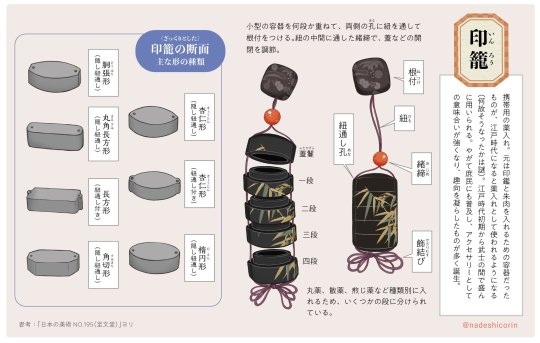
印籠 (inrô) pill box/nested boxes, handy chart by fantastic Edo-lover Nadeshico Rin.
Inrô were first used during Sengoku period by men to carry their personal seals (印鑑 inkan) and thick red ink (朱肉 shuniku). It was then used to carry medecines (薬 kusuri), such as pills (丸薬 ganyaku), powders (散薬 sanyaku), or decoctions (煎じ薬 senjigusuri). Slowy people also added any small trinkets which could fit in.
First carried by samurai class, it then spread to chônin commoners in the Edo period. Many shapes existed, and inrô boxes could be made from many materials depending of their owners’ fortune, from paper to precious ivory. Often beautifully decorated, their designs could include raden (mother of pearl inlays), or makie (gold powder).
On the right, you can see the different part of an inrô:
根付 (netsuke) carved toggle (sometimes very intricated miniature sculptures), slipped into the obi belt
紐 (himo) cord, holding everything together
緒締 (ojime) string-fastener bead, could be made from precious coral or as decorated as netsuke
飾結び (kazari musubi) ornamental knot, at the bottom
紐通し孔 (himodôshiana) lacing hole, to thread the cord into the boxes
蓋鬘 (futakazura) top piece, lid of the box
段 (-dan) row of boxes, ex. 一段 (ichidan) first row
Main types of inrô shapes existed, with of without visible lacing holes (紐通し付き himodôshi tsuki = visible / 隱し紐通し kakushi himodôshi = hidden). Rin details following styles on the left:
杏仁形 (kyônin gata) apricot seed shaped
楕円形 (daen gata) ellipse shaped
胴張形 (dôbari gata) hull shaped
丸角長方形 (marusumi chôhôkei) rounded rectangle shaped
長方形 (chôhôkei) rectangle shaped
角切形 (sumikiri gata) cut-corners shaped
#japan#fashion#fashion history#edo period#references#ressources#nadeshico rin#inro#inrou#pill box#medecine box#kusuri#samurai#raden#mother of pearl inlay#makie#gold powder#netsuke#toggle#chart
438 notes
·
View notes
Photo





Will post progress on witchy witches here.
[done]
[25.07.18] Rin Kazari - sansha_npc_frigate (Incursion’s Niarja in particular), no shadows and lights applied yet.
[26.07.18] Mei Menowa - Phantasm - lineart, colors coming soon.
[27.07.18] - Phantasm in colors now. Will update with more details after all others are done to keep them closer to common style
[28.07.18] - Kotetsu Katsura - Succubus, incomplete lineart, needs more fixes.
[29.07.18] - Succubus now is colored too. Slight mismatch in details’ color - should make them darker in next pass. Added missing spikes on the back.
[30.07.18] - Kanna Utsugi - Nightmare - lineart, colors tomorrow.
[31.07.18] - Nightmare has come.
[01.08.18] - Tanpopo Kuraishi - Revenant - sketchish line art, had to rework pose completely, looks more like commander now.
[02.08.18] - updated lineart, changed some parts completely due to them be boring. Body parts’ proportions might need slight fixes.
[03.08.18] - Colored Revenant. Slight fixes of the eyes.
Now all that’s left is to add shadows, lights and all the other shiny stuff to make them more appealing.
#eveonline#witchcraft works#rin kazari#mei menowa#kanna utsugi#tanpopo kuraishi#kotetsu katsura#mechamusume#shipgirl#fanart#antropomorphic#moefication#sharp spiky scary ships
1 note
·
View note
Text
i fucking love how Witchcraft Works ends its first episode with these 5 badass and very characteristic villains and left me thinking “oh shit, protag and kagari are gonna have to fight each one throughout the show arent they?”

but then episode two rolls around and withing the first 5 minutes theyre already taken care of and are clearly no match for kagaris fire magic

#i wanna see more of them though!!!#what are each of their abilities??#tanpopo is cute and needs more screentime!#PLS#Witchcraft Works#WCW#tanpopo#kazari rin#katsura kotetsu#menowa mei#utsugi kanna#anicaps
3 notes
·
View notes
Photo



19 notes
·
View notes
Photo

418 notes
·
View notes
Photo


112 notes
·
View notes